"Gambei" is Chinese and means "cheers", I thought - and was soon proved wrong. "Gāoxìng!", or something similar, was the better expression, because "gambei" means "dry glass" and requires that you empty it in one go, which corresponds to our "ex-drinking". The only difference is that here - especially among students - this is practised with beer, but hardly ever with wine.
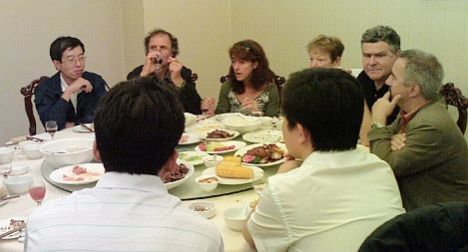 |
| Our first experiences with the term "gambei" at "Dynasty" in China |
I was surprised when even weighty representatives of the Chinese wine industry pronounced one "gambei" after another on our wine-tasting tour - accompanied by good wishes. Even though the glasses served were significantly smaller than our wine glasses, we gave up after the third toast at the latest, despite being immoral and rude. From then on, we drank the usually very good wine only in sips and with caution. Perhaps the drinking custom "gambei" reveals a piece of Chinese wine culture. "Wine" is not wine, but an alcoholic beverage, including "white wine", which is not made from grapes, but from grain. On the wine list in the restaurant, therefore, we find under "Wine" not only red and white wines, but also high-proof drinks, from rice schnapps to whisky.
This mixture of terms is probably also the source of the "vouched-for" stories in which "Chinese people mix the expensive Petrus with cola or slam a full Petrus bottle against whitewashed walls". Wine lover Artur Krueger correctly diagnoses: "It's all urban legends! Those who buy the stuff know very well what they are buying and will do neither. Exceptions prove the rule."
 |
| Everything is a bit bigger% more gigantic in China. Wine production too. |
In fact, there was a time - around the mid-nineties - when it was chic to mix wine with a sweet drink - cola, for example. Because dry wine does not correspond to the "taste" of the Chinese. And yet there is a considerable consumption of wine in China as well: on the one hand, it is the wealthy Chinese, business people, from home and abroad, who drink - predominantly - imported wines. Wine has become a prestige good in China, and like a refrigerator and a car, it is increasingly part of lifestyle and luxury. On the other hand, it is younger people, between 20 and 35, who live in urban areas and earn relatively well. Although wine consumption is also increasing in bars and "in" places, wine is often still mixed with lemonade.
According to statistics, less than one percent of the population consumes wine in China. For a long time, the considerable wine imports (today about 45 million litres) were targeted at foreigners living in China. This has changed. More and more often, imported wines are also found on restaurant menus preferred by locals. Here - as we were repeatedly assured - it is more about gaining status than about a taste experience. Our own experience confirmed this: Wine glasses as we know them for the different wines or even tasting glasses are rare, even at tastings at renowned wine producers.
Changyu, the oldest wine production in China, welcomed us in the pompous conference hall of the Wine Culture Museum. After all, they provided six wines, but with glasses that were far too small and not at all suitable for wine, no spittoon and certainly no documentation on the wines. After about a quarter of an hour, the eloquent export manager arrived. Only after she had studied our business cards did she order both spittoons and proper wine glasses. For the second and last time on our China trip, there was something like a real tasting with different wines for comparison. But the wine expert did not want to talk about the wines themselves, their qualities, their characteristics, the composition of the grape varieties, the production methods. Only about figures, successes, export opportunities, wine history, company structures...
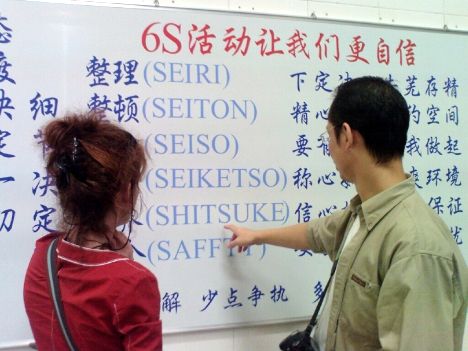 |
| The influence of the French wine tradition is visible everywhere in Chinese wine production. |
Later, in the wine shop, I wanted to buy the company's best red wine to bring it to Switzerland for re-tasting. The best one was about twice as expensive as the third best. When I asked about the difference in quality, they said: there is no difference, the wine is the same in all three versions, only the presentation, the bottle, the label are different: people's version and luxury version. Wine is a matter of prestige in China.
In the hotels and restaurants frequented by tourists and business partners from abroad, there are usually both domestic and imported wines. Moreover, at least one person in the service department knows how to handle wine. But for the vast majority, wine culture is a subject that has not (yet) been taught in service training.
In typical Chinese restaurants, on the other hand - even where Chinese food is very good - there is usually only one white and one red wine to choose from, served in a standard glass that is also used for beer. Other glasses are hard to find. Handling the corkscrew is also often an amusing spectacle: lucky if the cork is out after five minutes and not floating in the bottle. Decanting or something like temperature adjustment: completely unknown.
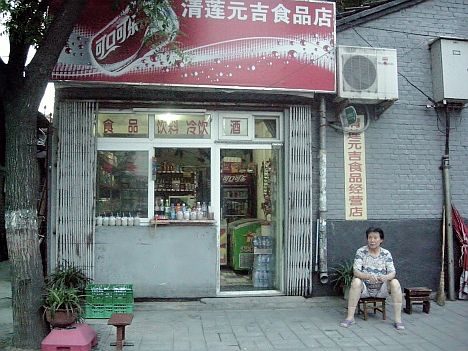 |
| Drinks shop in China. This is where people do their everyday shopping. There is hardly any wine there. |
The most important criterion for choosing wine in China is the country of origin and - at best - the grape variety. Growing region, vintage, assemblage play almost no role. Cabernet Sauvignon dominates among the reds. If it comes from France, it is already a top wine for the Chinese. In the low-price segment, the wines mostly come from Italy, and in the middle segment it may be Spain, Australia or North America.
For us "Western" wine drinkers, one thing is difficult to comprehend: the "blending" of wines. There are hardly any regulations and no transparency. A Cabernet Sauvignon must contain a majority (more than 50%) of Cabernet, but what else is added, which wines, which grape variety, which vintage, imported or own production, remains a "trade secret". Our questions were always answered with friendly but icy silence.
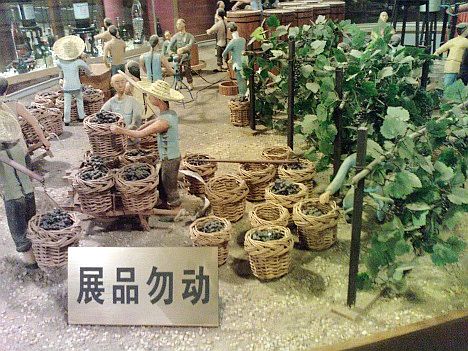 |
| We only met winegrowers in the vineyards in showcases in the museum. |
Only when one pays attention not to everyday life but to statistics does the importance of China in the wine world of the near future become clear. Today, the Chinese already drink 390 million litres of wine, which is still very little for 1.3 billion people (0.3 litres per year). But if wine consumption increases - everything points to this, and wine sales are strongly promoted by the government - then China will soon need one billion litres of wine per year (at 1 litre annual consumption). If even European wine consumption were to take hold in China (30 or more litres per capita per year), wine would soon be in short supply worldwide.
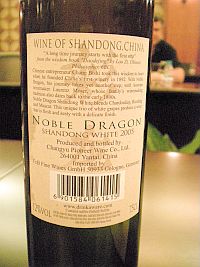 |
| English labelled% ready for export. "Nobel Dragon"% White wine from Shandong. |
China already produces 90 per cent of its own needs and also exports wine to the West. Thirty countries are said to be customers already, exact figures are not available - only company information. Vines are already growing on about half a million hectares in China, with an increase of about 15 percent every year. You don't have to be a statistician to calculate when China will have the largest vineyard area in the world (if the development continues like this). The conditions are good: more than 50 percent of the population is engaged in agriculture, there is an infinite amount of cultivable land, and the northern regions have favourable conditions for growing vines. Only in winter it gets very cold, so the vines are buried in the ground. But there is no shortage of staff in China.
"Long-term plans", we were told again and again, both at Dynasty Winery and at Bodega Langes, at the state enterprise Great Wall and at the "export kings" Dragon Seal and Changyu Winery. At least we said goodbye there with the promise: "See you again at the "Pro-Wein" in Düsseldorf. But then without the ritual of "Gambei"!
Cordially
Yours/Yours
Peter (Züllig)